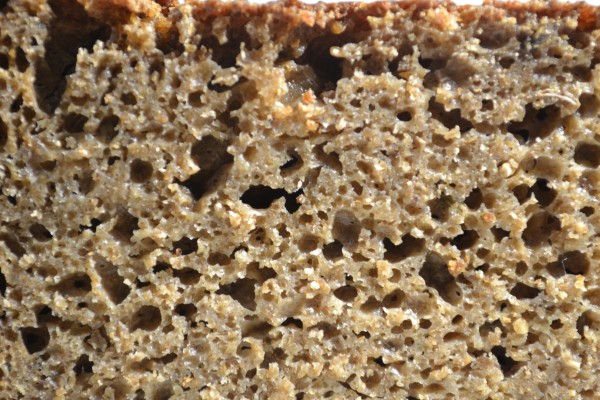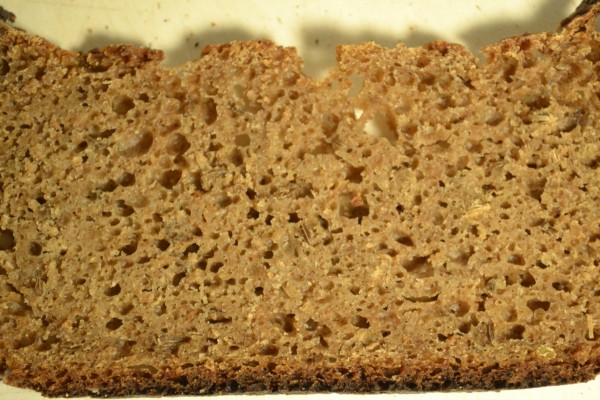Thanks to the outstanding help and wonderful pieces of advice I got from Karin (hanseata), Khalid (Mebake), Juergen (Juergen Krauss) in my previous thread about Schwarzbrot (http://www.thefreshloaf.com/node/33787/schwarzbrot), my (actually, I should say our) tweaking of the original recipe produced a delicious, much improved black bread!
Very tasty, with a very deep, distinct rye flavor, it provides a delightful munching experience. Its crumb looks incredibly nice. In all these aspects, and many others, this version showed marked improvement with respect to the original recipe.
Additional notes: (a) this version had a much slighter hint of sweetness than the original one, (b) black coffee and dark chocolate were totally dropped from the original formula, (c) the amount of dark molasses was halved, (d) the introduction of new techniques (biga, autolysis, retarded fermentation) in the method also permitted a drastic reduction of the amount of active dry yeast: from 8.5 g in the original for-bread-machine version to 1.0 g in this tweaked hybrid-method version (besides imparting the bread a much better, deeper rye flavor).
I believe this version is perfectly suited for some smørrebrød!!! I guess I'll try this tonight!!!
Here are some shots of this Schwarzbrot!





The new, tweaked formula, that incorporates several ideas provided by Karin, Khalid and Juergen, is the following:
BIGA-BASED SCHWARZBROT (FOR BM) (TWEAKED RECIPE)
final dough: 62,5% rye, 75,0% hydration
yield: one 700-g loaf
Ingredients
Biga (65,0% hydration)
200 g rye flour
130 g water
0.5 g active dry yeast
Dough
110 g lukewarm water
120 g unbleached white flour
1 tsp salt
2 tbsp dark molasses
1.5 tbsp vinegar (or buttermilk or yogurt)
3 tbsp soft butter
0.5 g active dry yeast
1 tbsp caraway seeds
0.5 tsp fennel seeds
Note: in another thread (http://www.thefreshloaf.com/node/34043/biga-flourwater-autolysis), I've been dealing with the possibility of scaling down the above biga.
Here are shots of slices (using different, improved lighting for the shots):


As to the method, it started with the biga that rested for exactly 8 hours. This was then incorporated into a 30-minute autolyzed mix of white flour and water. With the help of the Dough cycle of my bread machine (yes, ... here it goes again), I incorporated the remaining ingredients (the salt was gradually sprinkled all over the dough after 5 minutes into the Dough cycle; the same was done with the seeds after 10 minutes into this cycle). The final dough was then retarded in the fridge for 17 hours (chosen to fit my Sunday schedule). [edited on July 10] After a total of 2 hours that were needed to get the dough back to room temperature and to go thru a 75-minute proofing period [edited on July 10], it was baked for 1 hour in the bread machine. Another 15 minutes in a preheated 220 degrees C conventional oven were necessary to give it a nicer crust. Finally, the resulting loaf sat untouched (before any slicing was done) for 18 hours.
My take on this experiment: "Learning is always a great, rewarding experience! Learning from you girls and guys here, at TFL, is moreover easy and fun!"
Thank you all. Have a great week! Bruneski.
loaf!
Spotted two possible improvements for the looks...
Have you tried skipping the 2 hr warm up from the fridge? I get so hungry when I see rye I can almost taste it!
Yummy!
Thanks for the nice comments/suggestions! We looooooooooooove rye bread!
So far, I`ve been working on/trying to master the recipes of a grain-loaded Swedish Rye (http://www.thefreshloaf.com/node/33894/bigabased-30minautolysed-7hourbulkretarded) and of this no-grain Schwarzbrot! The slightly tweaked versions of the for-bread-machine recipes I got from the internet are already yielding incredibly good results, thanks to the introduction of three new techniques (biga, autolysis and retarded fermentation) I learned from you people at TFL. However, I`m still letting my bread machine do most of the heavy/hard/time-consuming work.
I`ll probably use each of these tweaked versions once more before turning the focus to a for-bread-machine Pumpernickel recipe I`ve baked once before (with nice results). I will also try a couple of very interesting rye bread recipes, a German rye/whole wheat "house bread" and Feinbrot, Karin (hanseata) gently offered me.
The two ideas you presented above sound mighty interesting! I`ll certainly try them in my future loaves!
As to the 2 hours (120 minutes) spent returning the dough to room temperature before baking, I forgot to mention that this included 75 minutes of proofing, since in the 17-hour retarding period the original final dough "grew" (fermented) very little (the original text has already been edited, on July 10, to include this additional piece of info).
Have a great day! Bruneski.
Roggen Schwarzbrot. To make it more 'black' I would leave in the tsp each of instant coffee and cocoa too. The bread will taste nearly the same - only better :-)
Happy baking
... Herr dabrownman (or should I say Herr derbrauneMann)!
Thanks for the suggestion on how to darken it further! Already jotted it down!
Have a great day! Bruneski.
pumpernickel it for a darker swartz color too.
What is "to pumpernickel" it???
By the way, what is pumpernickel flour? I believe this isn`t available in my immediate vicinity.
Take care!
no such flour as pumpernickel flour since there are no pumpernickel berries or even pumperdime berries that you could cut in half. Some marketing folks at some companies that sell flour that they don't even mill themsleves, market a medium supposed whole grain rye that they call Pumpernickel flour.
What makes pumpernickel is how it is baked. Long, low and slow with reduced heat adn fully covered to steam in its own liquid - up to 12 or more hours is the norm. I like several different baking schedules that generally start out at 350 F for one hour and then reduce the heat by 25 degrees each hour for 2 hours and then use 25 degree reduced temperature on 2 hour increments until you hit 200 F and then 4 hours there. Then turn off the oven and let the bread sit in the off oven to at least 8 hours.
Yes, ... the Maillard reaction !!! If only I had the time and the patience to do it in my conventional home-kitchen oven.
But, seriously, I`m considering baking a high-percentage-rye bread using the pumpernickel baking method you described above! Some day in the not so distant future!
Take care.
for pumpernickel but any toaster oven would work since the max temp is so low and tha big oven would be expensive to heat up. Changes the taste of the bread completly.
I`ll keep this in mind! Take care.
Geeze, you disappoint me dabrowny. I thought for sure you would use squid ink! ;) You creative man you.
John
Nice result, Bruneski, and Mini is right-on with her advice. I would not listen to some people's suggestions, probably under the influence of too many hemp seeds, to americanize your nice German Schwarzbrot (boooh, DBM!)
Just kidding,
Karin
Thanks mainly to you people from TFL, I've been learning a lot of interesting, helpful things really fast!
My only 'problem' is that, on average, I only bake 3 to 4 loaves a month! This obviously slows down both the learning and the experimental processes.
Have a great week! Bruneski.
I'm glad it turned out well for you, bruneski! excellent bread. How lovely and "magical" it is to have fresh bread made for you, ready when you come home!
Wishing you all the best,
-Khalid
Very nice of you.
Take care.
Nice improvement bruneski. Listen to Mini's suggestions and you will on your way to a perfect loaf. I am sure this one tastes great though.
Happy baking.
John
... it does taste great! It also 'feels' great!
I'm learning!
As mentioned above, the help/hints/tips/advice I've been getting from you people here at TFL are some of the most important reasons behind the shape of my learning curve!
Thanks for comments/incentive! Take care!